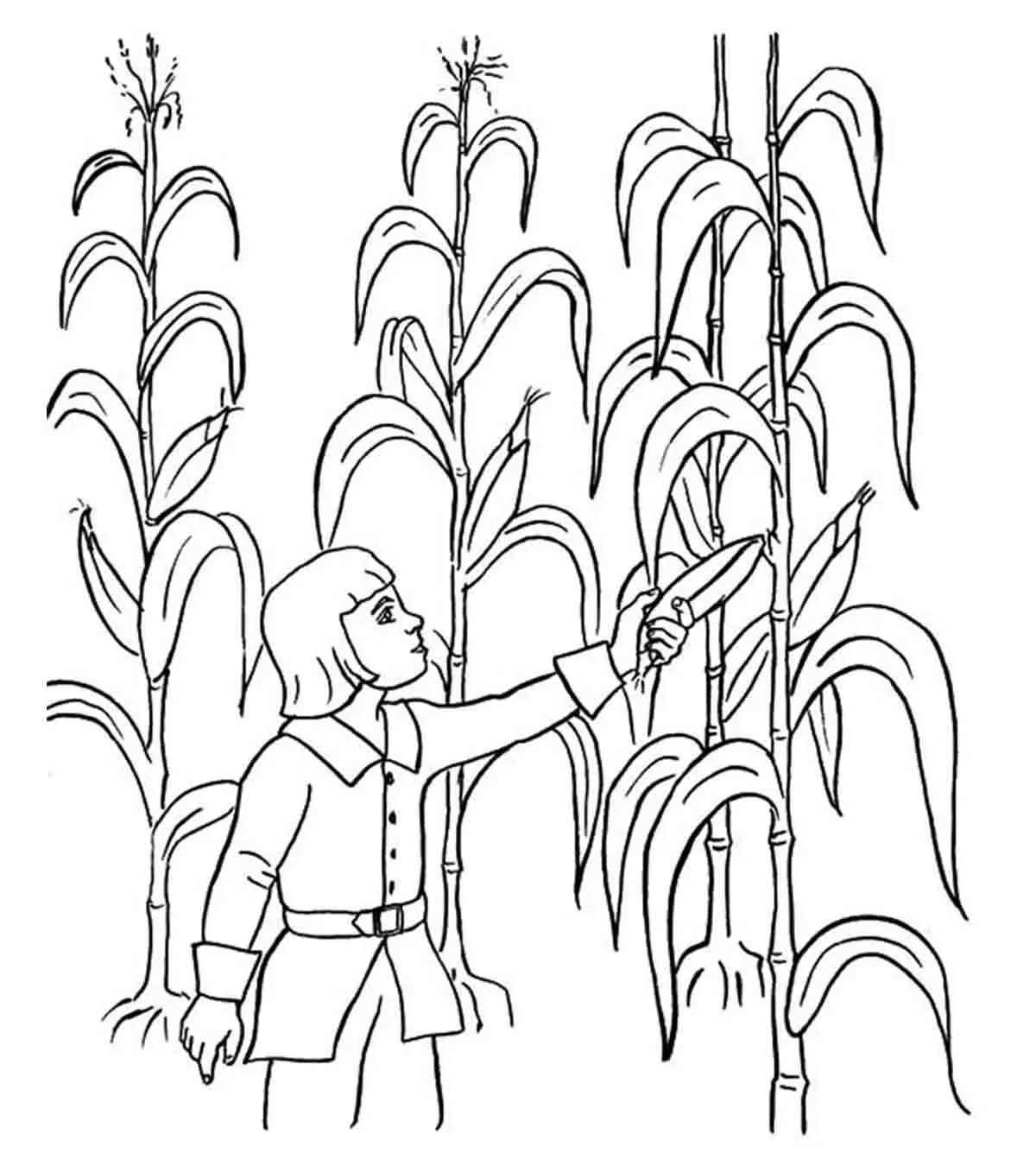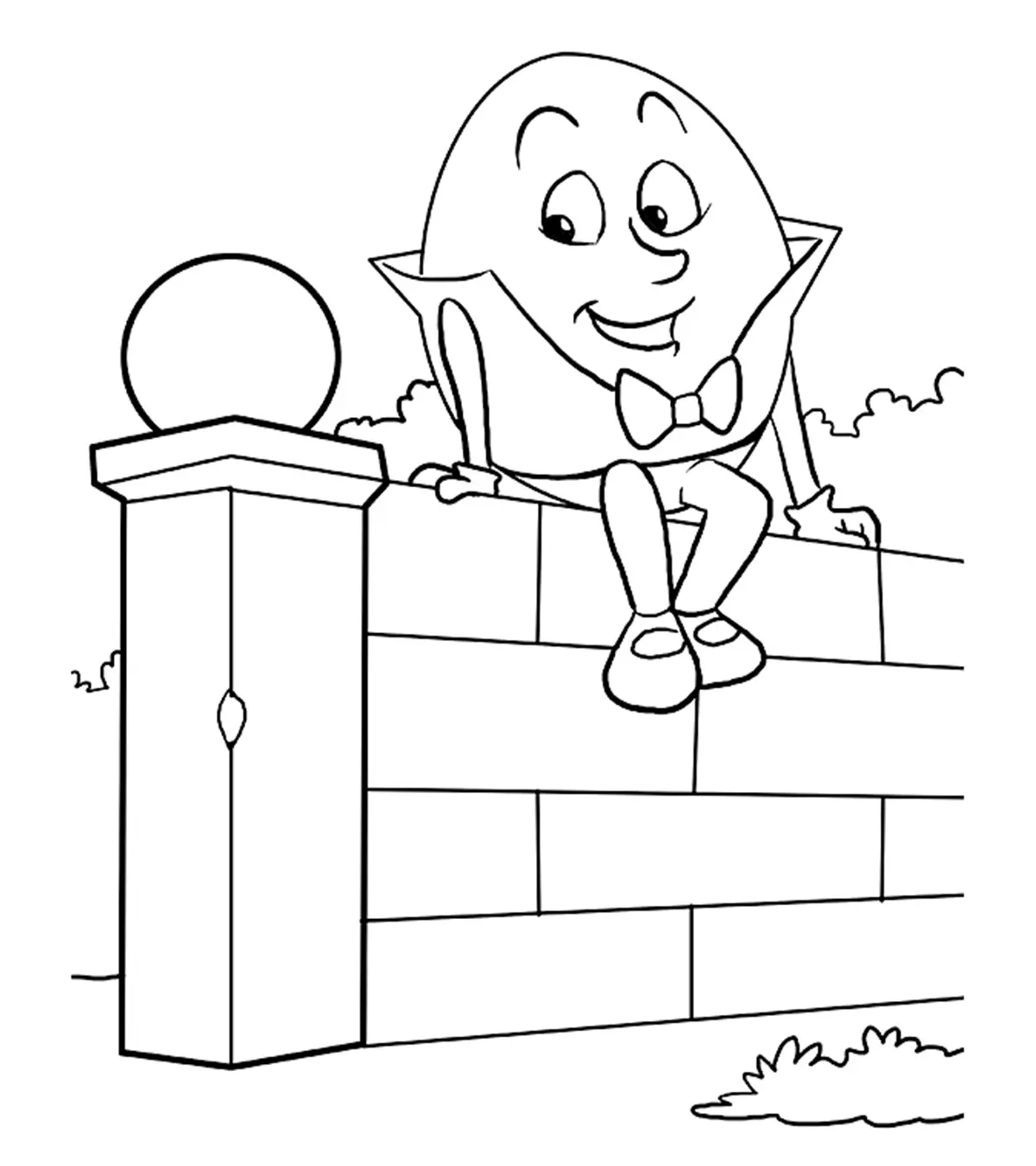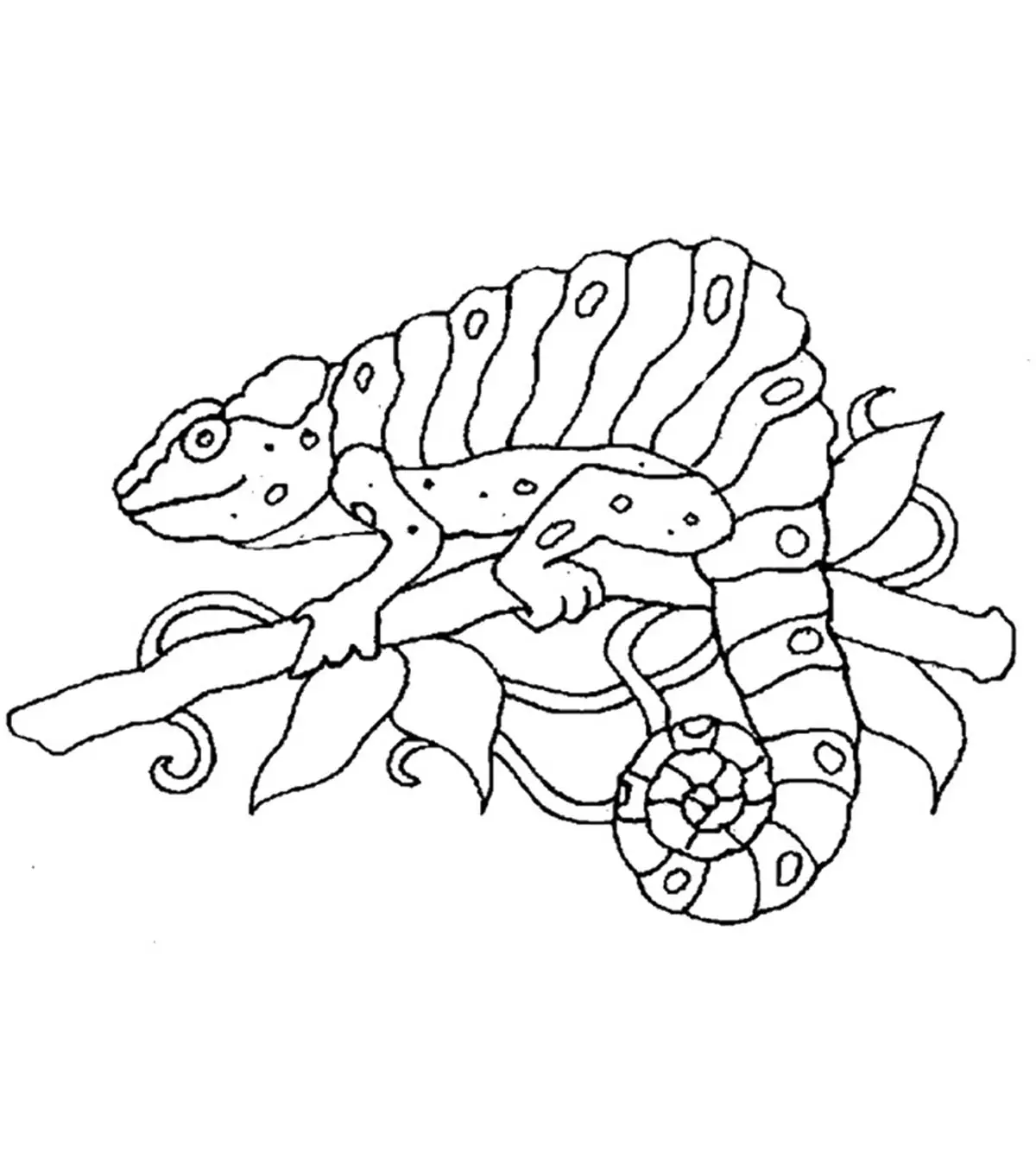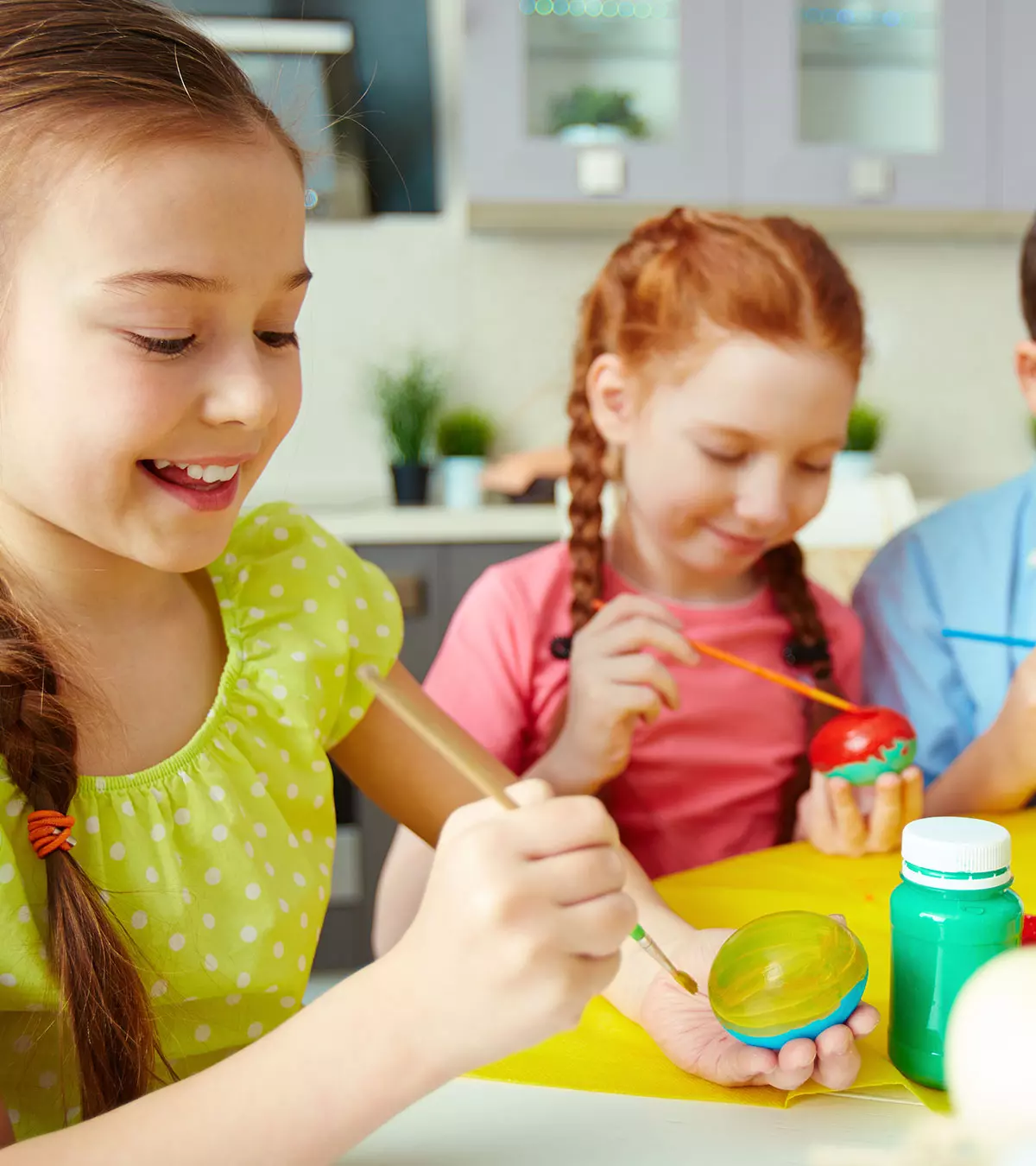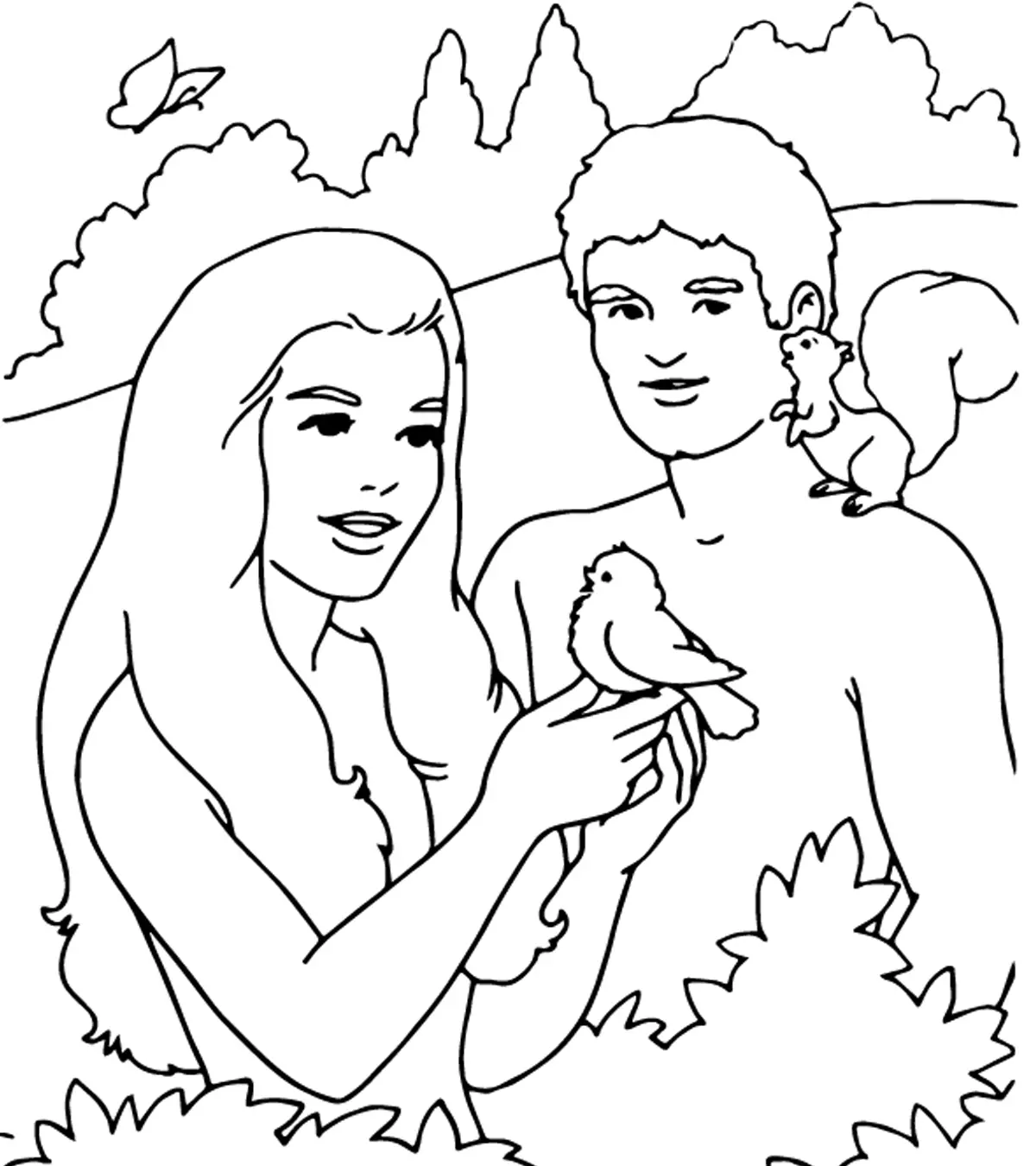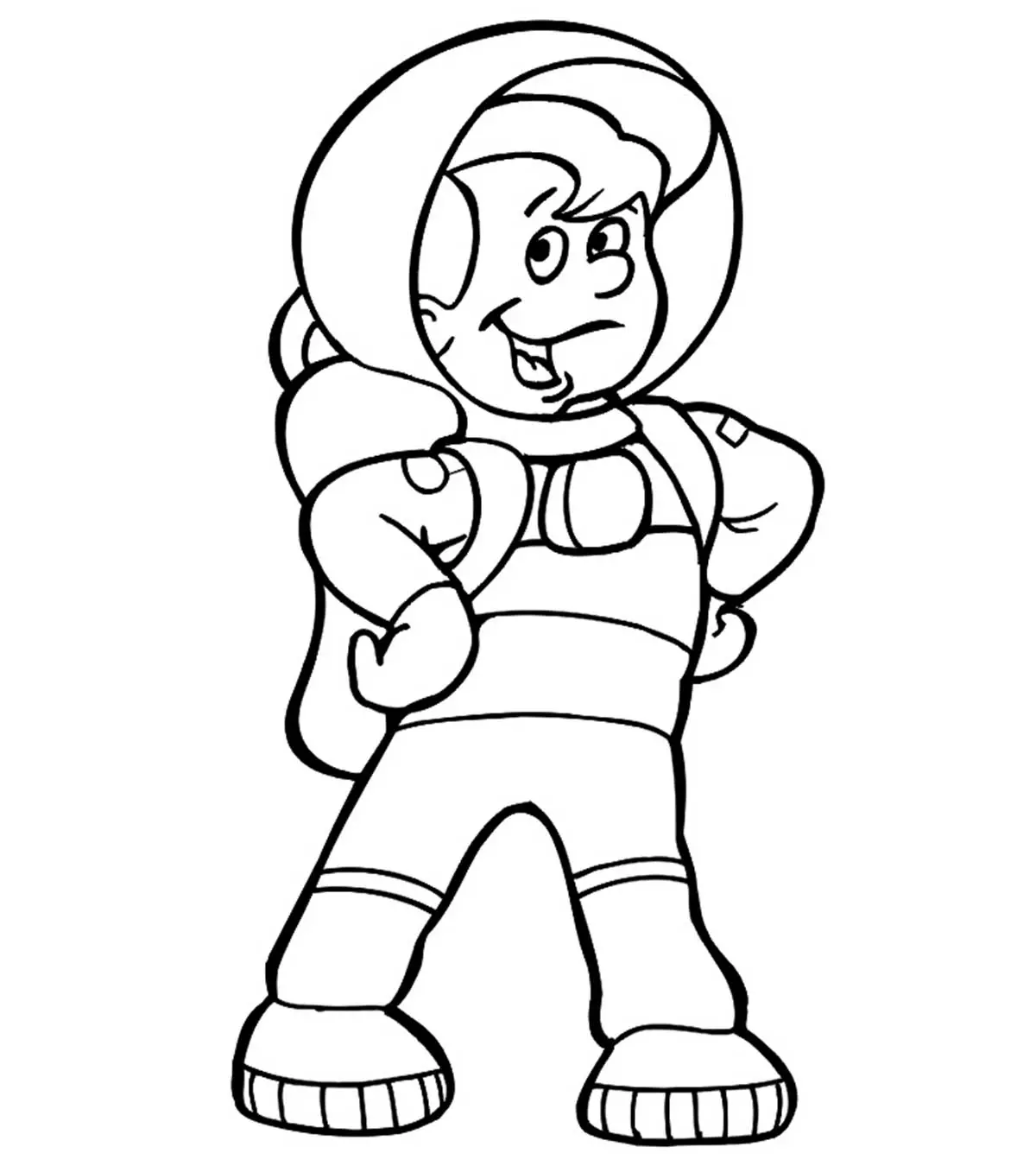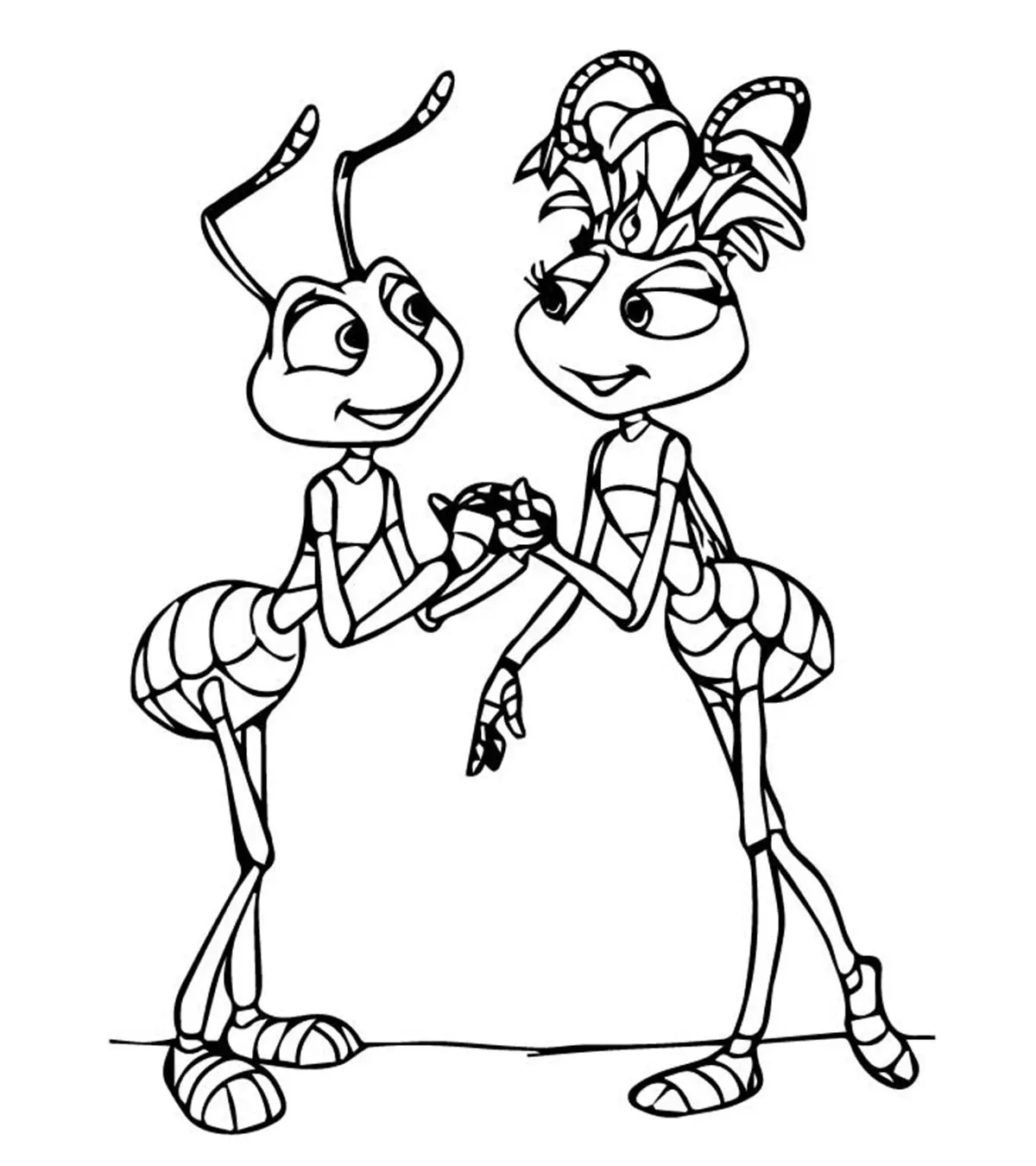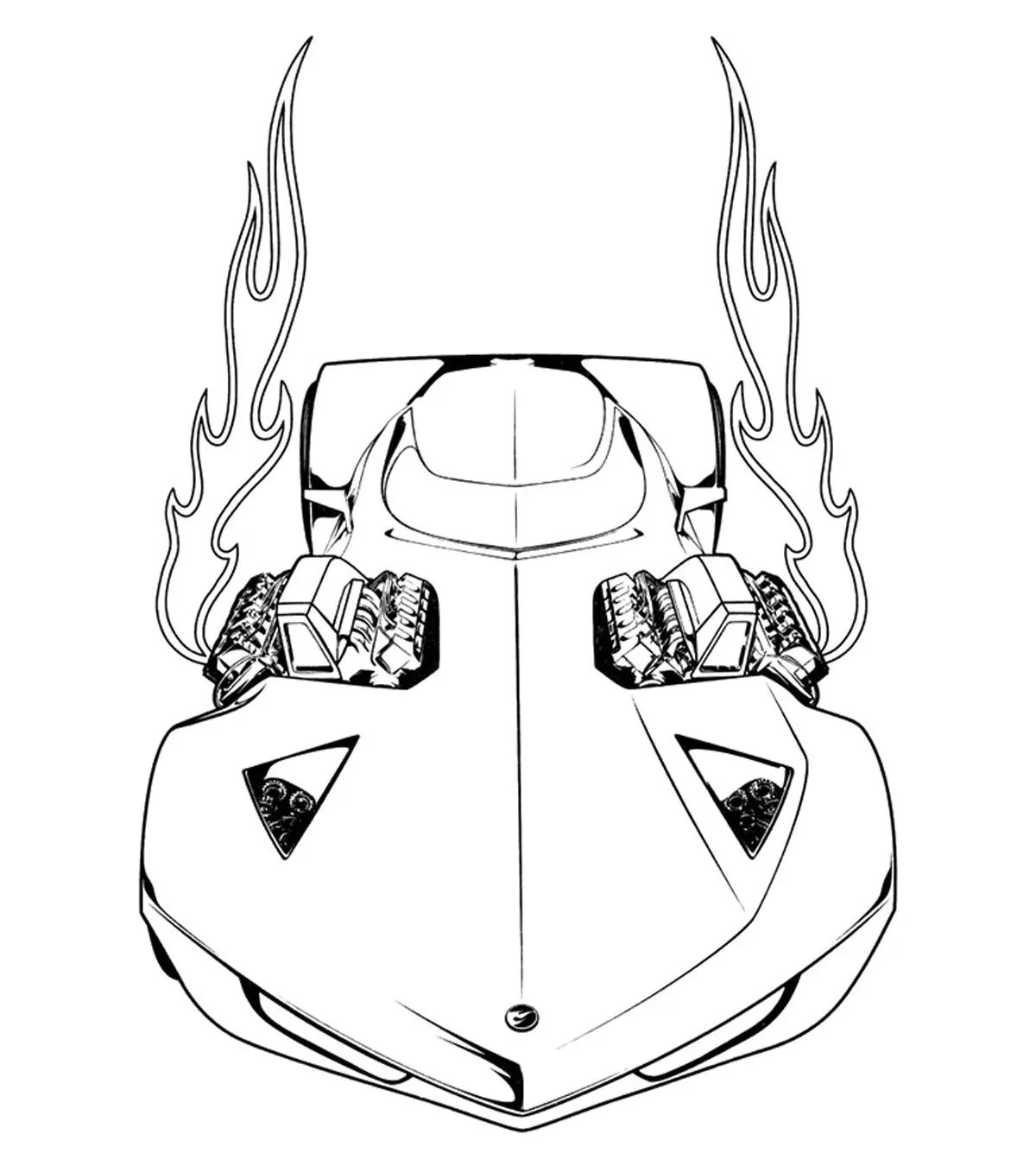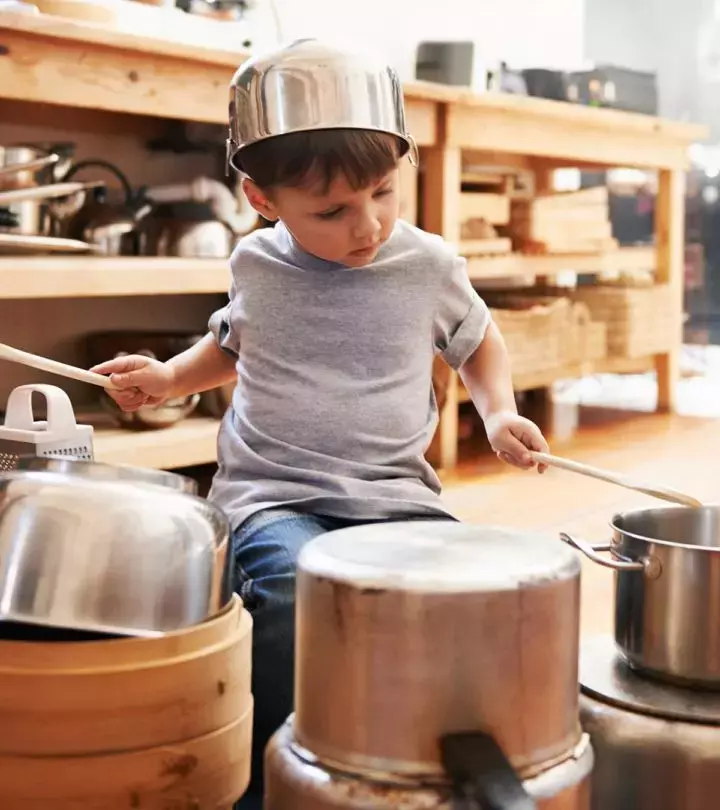
Image: iStock
As children, we all have imagined having superhero powers and fighting villains. Such pretend play for kids is beneficial as it fires their imagination and makes them creative. Even if it is wearing mother’s makeup and clothes as a costume or acting like a school teacher, the pretend play game takes them into another fascinating fantasy or make-believe world. It also helps keep the children entertained for a long time and boosts their physical and mental skills. In this post, we bring some interesting pretend play ideas and games that encourage them to play and enjoy more. You can also make beautiful memories by recording your little one’s imitations.

Key Pointers
- Pretend play benefits a child’s linguistic, problem-solving, and social skills development.
- Babies show the signs of pretend play from the age of one to two years when they start to imitate the activities they observe.
- Plays such as Dr. Dolittle, Fairyland, Detective, and MasterChef are examples of pretend play.
When Do Kids Start Pretend Play?
Babies aged one to two years start showing the first signs of pretend play as they imitate the actions of adults they see around them. When toddlers reach three years, their thinking and imagination skills develop, and they learn to use regular objects as symbols (1) (2). Apart from gestures, they now try to talk or pick up peculiar behavior that they notice in adults.
Benefits Of Pretend Play For Kids
Pretend play is highly beneficial for a child’s mental and physical growth. The following are some reasons why you must encourage your child to indulge in pretend play.
- Linguistic skills: Pretend play helps a child develop linguistic skills (3). When children imitate adults, they use words and phrases that adults usually use. As they reenact scenarios with their friends and use these words and phrases, they learn to make a connection between written and spoken language (4).
- Problem-solving skills: When children imitate adults and imagine themselves in certain situations, they learn how to adjust and react like adults. For instance, if they are playing a game in which two children want to play the role of their teacher, they will have to find a solution to continue playing the game (5).
 Point to consider
Point to consider- Social skills: Pretend play helps children develop social skills and explore complex social ideas (6). For instance, if your child has taken up the role of a superhero and their friends are evil enemies, they will have to learn how to allocate characters to each one and remember to allow every child to become a superhero, and know how to react to others’ actions. Funny enactment can elicit a good laugh from all the children involved in the play.
A study of 100 children aged between 3- to 6-years in the United States revealed that the children usually preferred to carry out actual tasks over pretend ones, such as cutting vegetables. In addition, children frequently mentioned that they enjoyed practical real activities because they wanted to assist their parents in chores. Children endorsed hands-on activities as they found them highly engaging and fun.

Preference for real or pretend play/activities among young children
Source: When it’s playtime, many kids prefer reality over fantasy; Science News/Developmental ScienceSource: When it’s playtime, many kids prefer reality over fantasy; Science News/Developmental Science
30 Pretend Play Ideas For Kids
Pretend play can be a form of adventure if your child imagines it to be one. Here are some ideas that will engage your child in pretend play.
1. My tiny house
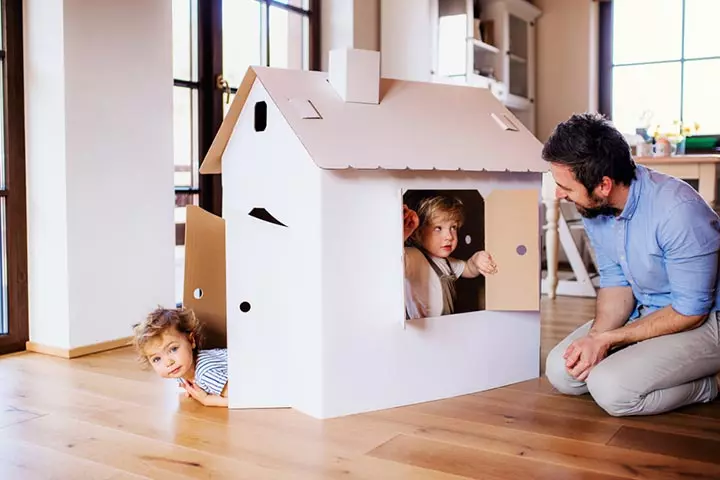
Using pieces of cardboard, build a small house for your little one. You could place a stool inside it so your child can sit comfortably. Create windows and decorate them with curtains using some old cloth. Let your child have their own house and take care of it like an adult. You can even insert symbolic play in this activity by giving a doll so it accompanies them in their little house.
Practical tips
- If you do not have cardboard, use strings to hang a large bedsheet or drape it over chairs to create a makeshift tent.
- Allow your children to decorate the tiny house the way they want to. Provide them with stickers and fairy lights to create a space of their own.
Challenges and solutions
- Limited space: Allot a corner of a room or a playmat to create the house’s boundary.
- Child loses interest: Create new themes for the tiny house. So, if today it is a dollhouse, tomorrow it is a superhero base.
2. Dr. Dolittle
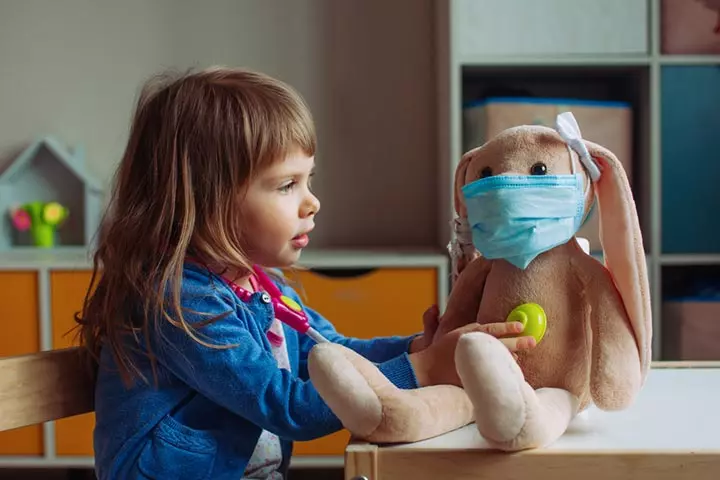
Get your child a doctor’s playset and some stuffed animal toys. They can wear a white jacket of their choice and pretend to be a veterinarian. Your child can then examine the health of these little animals and prescribe the medicines.
Practical tips
- Allow your child to feed the toys pretend food and tell them how healthy food can help those toy animals recover quickly.
- Teach simple animal care concepts like feeding, brushing, and checking for injuries.
Challenges and Solutions:
- Doctor’s kit not available: Use a small bag to make the kit. Roll a scarf and use it as a stethoscope, while cotton swabs can be used as medicine.
- Child not aware of what to do: Role-play as an animal that needs care, and guide them on how to take care of you.
3. Little mailman
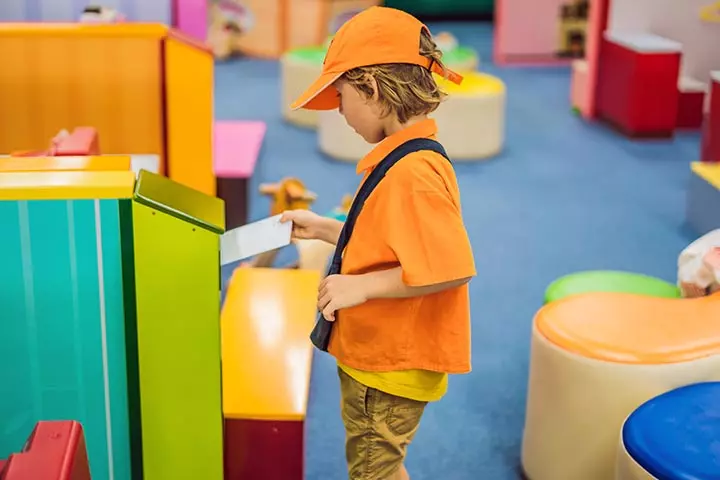
Create small colorful envelopes and stick them to a wall in your house. Write a family member’s name on each envelope. You can leave a mock letter in these envelopes, and your child can role-play a mailman, delivering each letter to the person to whom the letter belongs.
Practical tips
- Write simple one-line messages like ‘Mom! I love you’ or ‘You are the best sister.’
- Give your child a mailbag to carry and a small mailbox to collect letters.
Challenges and solutions
- No envelopes available: Fold regular paper into envelopes or use sticky notes.
- Child gets bored: Include a post office role, where they have to stamp and sort the mail.
4. Candyman

Your child can become a candy seller while you arrange for fake colorful candies placed in jars. You may act as a customer and ask your child to give you some candies and pay them some fake money. By the end of the game, your child can count their money and buy something from you with the money. This can also be an outdoor game if you set up a candy cart for your child in your backyard.
Practical tips
- Use small jars and fill them with colorful beads or buttons instead of candies.
- Create price tags to practice number recognition and pretend money for transactions.
Challenges and solutions
- Child cannot count properly: Use a visual price chart with images and numbers that they can refer to for counting.
- Messy play: Set up a small table with trays to keep the candies sorted and in one place.
- Choking hazard: Ensure your children are supervised throughout the playtime to prevent choking hazards. Consider using big beads and buttons instead of small ones.
5. The special town

Get your child miniature versions of their favorite superheroes. Paint some old cartons and biscuit boxes and use them as buildings. Now, your child has a new town filled with superheroes who will save the city from the apocalypse. Encourage them to try storytelling by creating a story around the town and its natives. This dramatic play for toddlers gives them the chase to create new stories.
You could improvise it further by adding the theme of a farm. Jackie, a teacher, shares how she prepares for her new themed dramatic play sessions. She says, “To begin the new farm theme, I put out tons of non-fiction books about life on the farm. We create an Idea Chart/Web. I task the students to “research” using the books (aka look at the photos). We discuss what farm animals, supplies, places, people, and food are on a farm. I use post-it notes so they will stick to the chart. It also shows me students’ prior knowledge and any misconceptions they may have… It gets the students excited for the next theme (i).”
Practical tips
- Use tape to create roads for the town.
- Encourage your child to create unique storylines for each superhero.
Challenges and solutions
- Lack of mini-figures: Draw or cut images from magazines to create your own superheroes.
- Child get stuck in storytelling: Ask them questions that can help take the story forward. For instance, ask them questions like, “What disaster happened? Who will save the day?”
6. The librarian

If you have a personal collection of books, you can ask your little one to arrange them and lend them to your family members like a librarian. Encourage them to have an interaction with the pretend library members. Of course, do not expect them to keep every book in its proper place and accept whatever the librarian gives you to read.
Practical tips
- Label books with paper slips and make a checkout card for each family member.
- Allow your child to play the role of librarian, customer, and even book restocker.
Challenges and solutions
- Child cannot read yet: Let them describe the books instead of saying their name. For instance, a book with a black-and-white cover can be called a black-and-white book.
- Books get misplaced: Keep a designated ‘returns’ bin so that all the books are collected in one place.
7. Fairyland

Create small tents with clean bedsheets and scarves. Use cardboard to create a pair of wings, a tiara, and a star wand. Now come up with a fairytale in which your little one is a princess of her town, and the citizens have to obey her orders. If she has friends over, she can play the role of a good princess who is known for her friendship with the common folk of the fairyland.
Practical tips
- Scarves can also be used to create a magical cape.
- Start the story by setting up a fairy tea party or a rescue mission for an enchanted forest.
Challenges and solutions
- Sibling rivalry: Allow your children to switch roles so that everyone gets an opportunity to play the role of their choice.
- No dress-up items: Use old fabric scraps and crowns made of paper.
 Quick tip
Quick tip8. Detective
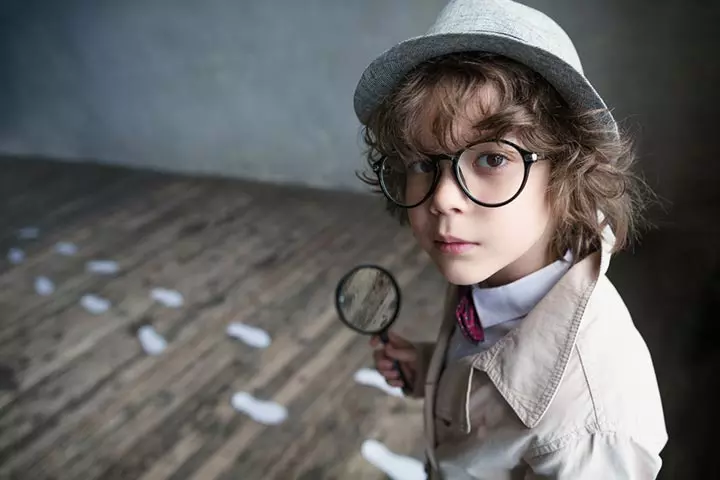
Buy a white round cap and a pair of extra-large glasses. Your child can dress in a smart pair of trousers and a shirt. Give them a fake magnifying glass, and let them act like a detective looking for clues to their lost soft toy.
Practical tips
- Hide an item and create a clue trail leading to its location.
- Provide a notebook and a pencil to let your child write down suspect details.
Challenges and solutions
- Child gets frustrated: Encourage them by starting with easy clues like ‘It’s under something soft.’
- Too much setup: Use a simple story like “Find the missing teddy bear.”
9. Kids market
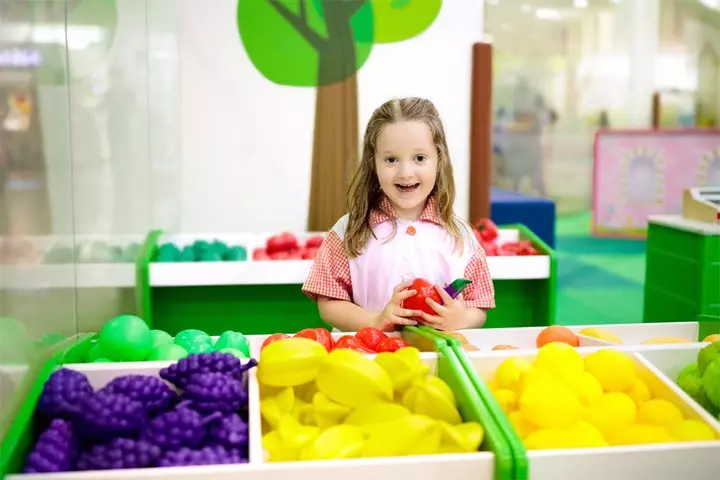
Has your child ever been to a market? Why not create a market for them at home where they can sell fake vegetables, fish, and meat? You can offer them fake Monopoly money and buy fresh veggies and fish from them. Try to bargain, and see if they lower the price.
Practical tips
- Use real grocery items like apples or cereal boxes for an authentic feel.
- Let kids practice counting by pricing items (e.g., banana = 2 coins).
Challenges and solutions
- No fake money: Use bottle caps or paper cutouts as fake money.
- Child struggles with bargaining: Demonstrate how to bargain with an actual vendor. For instance, share the questions they can ask such as “Can I get two apples for one coin?”
10. Masterchef

You can find tons of plastic kitchenware for kids in the market. Buy one that suits your child. You could also buy some plastic veggies and fruits and a chef’s hat. Allow your child to create their unique food item and relish their fusion dish.
Practical tips
- Your child can also create veggies and kitchen items with playdough.
- Let them serve their dishes and describe their ingredients.
Challenges and solutions
- Toy food unavailable: Use real ingredients. Mix flour with water to create pretend dough.
- Messy affair: Lay down a newspaper or use a plastic tray.
11. Pizza parlor

Cut a round base out of a pizza box. Next, cut the remaining pieces of the cardboard in the shapes of your favorite topping and then color them. Tell your child that you are hungry and want a pizza. Allow your munchkin with a chef’s hat to make a delicious pizza for dinner.
Practical tips
- Use magnets to make removable toppings for a more interactive experience.
- Add a menu board using a chalkboard or whiteboard where your child can write prices and take orders.
Challenges and solutions
- Messy affair: Use washable materials or pre-colored cutouts to reduce cleanup.
- Short attention span: Allow your child to switch roles, such as chef, customer, or cashier, to keep them engaged.
12. Makeup
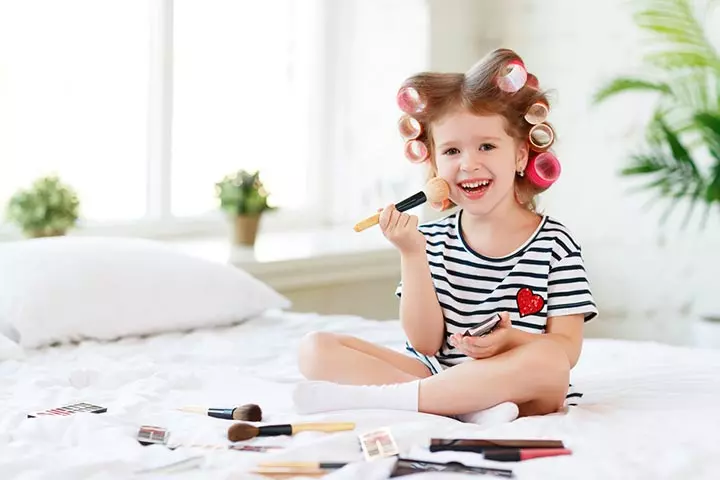
If your child loves playing with mommy’s makeup kit, let them try some makeup themselves. Let them apply makeup from a plastic makeup set and get ready to meet their friends or go shopping.
Practical tips
- Use child-safe, non-toxic makeup or a plastic pretend set.
- Set up a vanity station with a mirror and accessories like hair clips and brushes.
Challenges and solutions
- Concern about real makeup use: Allow your child to use makeup only for a stipulated time. Do not give them access to makeup in your absence.
- Spills and stains: Lay down an old towel or play mat to protect surfaces.
13. Doctor, doctor

Get a kid’s doctor set and tell them you feel unwell. Let them wear their white jacket and examine you with their stethoscope. Pretend to whine a little when they give you an injection, and take the medicines they prescribe you.
Practical tips
- Use dolls or stuffed animals as additional patients.
- Teach your child simple anatomy or first-aid terms like heartbeat, temperature, or bandage.
Challenges and solutions
- Fear of real doctors: Assure your child that doctors help them get better and be healthy.
- Loss of interest: Make them switch scenarios. Today, if they are doing a check-up, tomorrow they can attend emergencies or animal doctor visits.
14. Travel play

Arrange some chairs and place a soft toy on each chair. You may take one chair too. Hand your child a pilot’s control wheel or yoke. Tell them they are the pilot of the airplane, and that the toys are passengers. It is now up to the pilot to fly them to any location of their choice.
Practical tips
- Create passports and tickets using paper and stickers.
- Set a destination by projecting a landscape or playing nature sounds.
Challenges and solutions
- Sibling arguments: Swap roles between siblings so that everyone gets a chance to play the role of their choice.
- Limited space: Assign a corner of a room and use foldable chairs to save space when not playing.
 Do remember
Do remember15. Playdough bakery
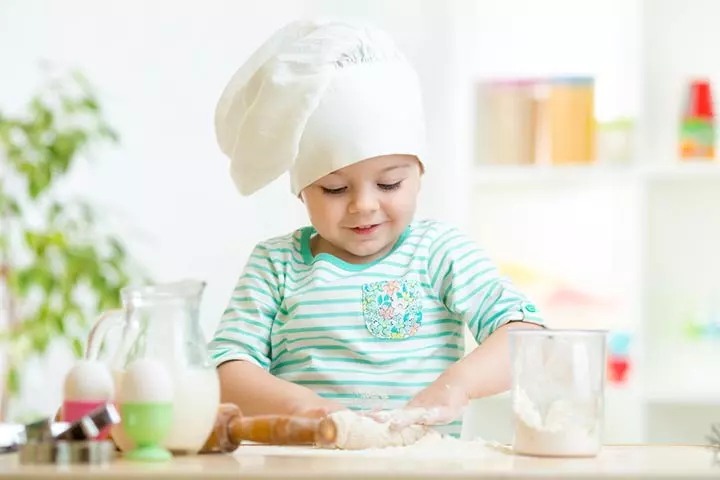
If your child loves sweets, let them open their bakery where they can sell cakes and pastries made of colorful play dough. Let them create their own cakes by mixing ingredients of their choice.
Practical tips
- Offer your child cookie cutters, rolling pins, and trays to shape dough into cupcakes or pies.
- Teach them math by pricing each pastry and selling it.
Challenges and solutions
- Playdough dries up: Keep it stored in airtight containers.
- Ingestion concern: Instead of playdough, use non-toxic homemade dough with edible ingredients like flour, salt, and water.
16. Camping at home

Let your little explorer set out camping but in the safety of your home. Bunch up some pillows as mountains and build a kid’s tent in your house where your child can spend some time like a camper. At night they can narrate scary stories using puppets. Do not mind if they trek around the house like an actual camper.
Practical tips
- Add a flashlight, books, or glow-in-the-dark stars to create authentic nighttime camping.
- Toast pretend marshmallows with paper or foam pieces.
Challenges and solutions
- Limited room: Build a tent using a table and sheets.
- Fear of darkness: Keep soft lights on or play calming music.
17. Office worker

Make a laptop for your child using a cereal box. Next, dress them up in smart formals. Let them sit at their table and work on the laptop the way they see their mommy and daddy work on their computers.
Practical tips
- Include a toy phone, notebook, or keyboard for pretend meetings.
- Let them type emails or file pretend reports using folders.
Challenges and solutions
- Boredom with desk tasks: Make it playful by pretending they are running a zoo or a detective agency.
- Desire for real devices: Give them an old keyboard or calculator to satisfy curiosity.
18. Music time

If your child loves music, a kid’s guitar or drum set or even piano will help them get into rock mode. Dress your child in some funky pair of pants and jacket and hand them their favorite musical instrument that they can play and pretend to perform a live concert for you. Encourage them to dance like a real rockstar.
Practical tips
- Create a band with pots, pans, or homemade shakers.
- Film their performance and play it back so they can see how they perform.
Challenges and solutions
- Noise overload: Set boundaries for volume or fix a time when they can play their music.
- Limited instruments: Use DIY options like rice in jars or elastic bands on boxes to keep the noise within limits.
19. Speed racer

Create the exterior of a car and a steering wheel using some old diaper boxes. Paint it in the color of your child’s choice. Let your child wear a cool pair of sunglasses and drive their way to the finish line.
Practical tips
- Add road signs, cones, or a finish line using tape and paper.
- Set up time challenges to make the game more exciting.
Challenges and solutions
- Tripping hazard: Clear the area before racing starts.
- Racing indoors: Take it outside or organize it in a safe, open space.
20. Little scientist

Your child might need some transparent plastic jars, colorful water, and a measuring cup. Allow your child to become a little scientist in their laboratory by conducting tests with colorful water. Tell them to mix liquids and notice how colors change as a result.
Practical tips
- Use food coloring, baking soda, and vinegar for fizzy experiments.
- Let them wear goggles or a lab coat for a more authentic feel.
Challenges and solutions
- Messy spills: Set up a tray or tablecloth to keep the mess under control.
- Safety concerns: Supervise closely and use only edible or safe ingredients.
21. Fisherman

Let your little one sit on a small basket and hand them a kids’ fishing rod. On the floor, scatter some fish cutouts with the letters of the alphabet written on them. You can glue on magnets or use a bent paperclip and punch holes in the fish so they can pick them up. Now, tell them to catch the fish of a particular letter. This way, not only will they learn letters but also hone their motor skills.
Practical tips
- Turn it into a learning game by calling out letters or colors to catch.
- Use a kiddie pool or blue sheet for the water effect.
Challenges and solutions
- Frustration with fishing mechanics: Use magnets or velcro to make it easier.
- Alphabet confusion: Start with letters that are familiar to your child and move on to other letters.
22. Anytime money
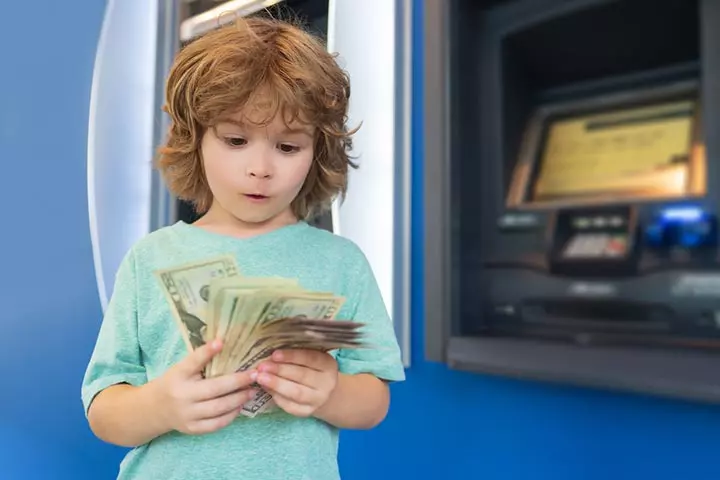
Do you want to teach your child simple calculations? Build an ATM box and place fake money in that box. You can hand a fake card to your child and let them withdraw some money from the ATM. This way, your child can learn numbers.
Practical tips
- Label play money with values and teach simple counting or transactions.
- Make a small ATM using a tissue box.
Challenges and solutions
- Difficulty with numbers: Assign your child simple tasks like sorting coins before moving on to more complicated tasks.
- Tearing of money: Make laminated or cardboard money for durability.
23. TV Star

Using cardboard, create a box big enough for your child to fit in. Cut out a window on the front. Your child can dress up any way they want and pretend they are on TV. Be the viewer and enjoy their show.
Practical tips
- Encourage your child to create weather reports, news segments, or talk shows.
- Use props like a mic or cue cards.
Challenges and solutions
- Stage fright: Join in as a co-host to help your child feel more comfortable.
- One-sided play: Involve siblings or friends as guests or audience.
24. Superhero

You don’t have to go to the theater to catch the new superhero film. You can watch them in your house. Create elastic cuffs with a symbol of your choice for your child, and tell them it is their superpower. For instance, draw lightning bolts on the cuffs, and tell them they can hit any flying object with those lightning bolts.
Practical tips
- Let your child design their own superhero logo and name.
- Create a mission around the house like saving a lost toy to make the game more interesting.
Challenges and solutions
- Rough play: Explain to your child that superheroes protect the innocent and are not just meant to fight with anyone.
- Unrealistic powers: The role should involve helpful tasks around the house to ensure your child learns from it. For instance, your child’s superpower can be their ability to clean their room in ten minutes.
25. Tea party
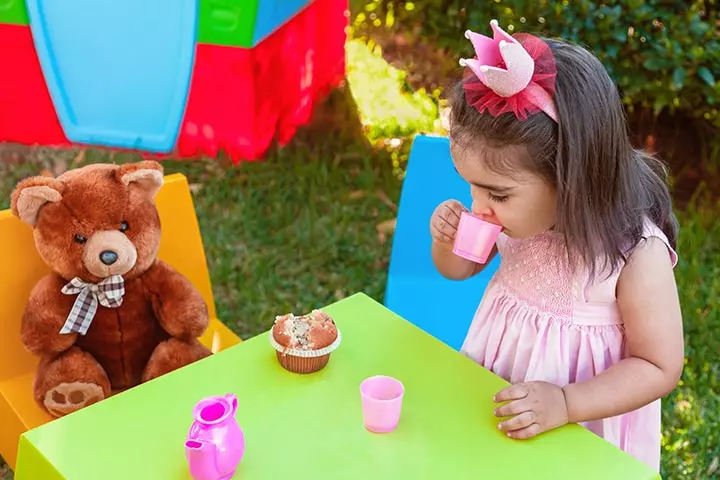
Gather all your child’s soft toys in one room. Ask your child to organize a tea party using some play tea set. Remember to let your child dress up and play a good host to their cute guests.
Practical tips
- Use real snacks like crackers or fruit for a realistic experience.
- Invite dolls, pets, or family members to boost interaction.
Challenges and solutions
- Spills and messes: Use a picnic mat and washable tea set.
- Short play duration: Extend it with storytelling or fashion dress-up.
26. Powerpack

Tell your child they can fly. Using two old plastic bottles, create a jetpack for your child, and let them wear it on their back. With the jetpack on their back, they can fly to any place in the world.
Practical tips
- Decorate the jetpack with stickers, glitter, or colored foil.
- Let your child travel to different countries and learn facts along the way.
Challenges and solutions
- Jetpack discomfort: Use soft straps and lightweight bottles.
- Flight confusion: Help them create a destination map to guide their adventure.
27. Car wash
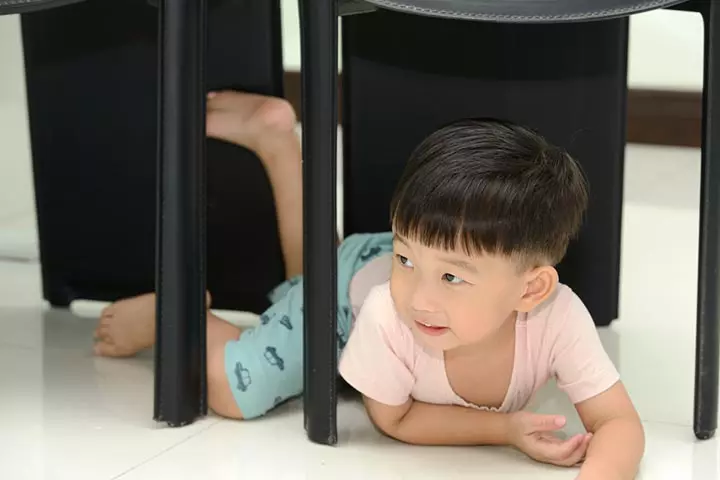
Stack a few chairs against each other and hang some clean socks from it. You can tell your child to crawl from under the chairs and cross the train of socks hanging from it. Like car wash, they too get clean and shiny each time they go from under the chair.
Practical tips
- Spray a fine mist of water or use pretend foam from shaving cream to have a more real-life experience.
- Add music or car wash sound effects.
Challenges and solutions
- Slippery floor: Use a towel path or avoid water altogether.
- Disinterest: Let them wash their toy cars or bikes too.
28. Neighbors
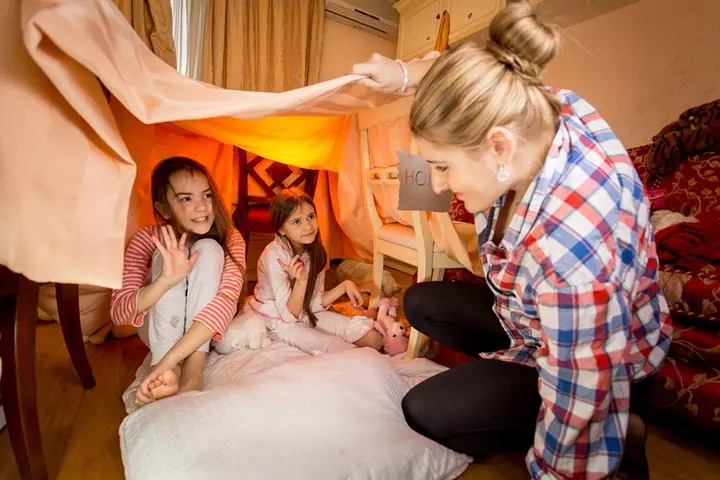
Build a home for your children and another home for yourself using mattresses and pillows. The two houses next to each other make you neighbors, and your children can acts as though they own the mattress house where they sleep, eat, and spend time.
Practical tips
- Create small household zones like a kitchen and a living room for a more realistic experience.
- Behave like real neighbors, borrowing sugar or having a playdate, for a fun experience.
Challenges and solutions
- Arguments over territory: Determine a clear space for each home so that each child gets their space.
29. Child care

Get a toy baby for your child, and ask them to care for them like a parent. They have to feed the toy, bath it, put it to sleep, take it for rides outside, and so on. In short, you are training them to care for a younger sibling if one arrives in the future.
Practical tips
- Include accessories like bottles, diapers, or baby clothes so that they know how to use them if needed in real life
- Have a feeding schedule or nap routine to mimic real life.
Challenges and solutions
- Loss of interest: Introduce new scenarios like going to the park or a visit to a doctor.
- Over-dependence on dolls: If your child has a younger sibling and they are old enough to play with them, then they can care for their younger sibling instead of dolls.
30. Ice cream parlor
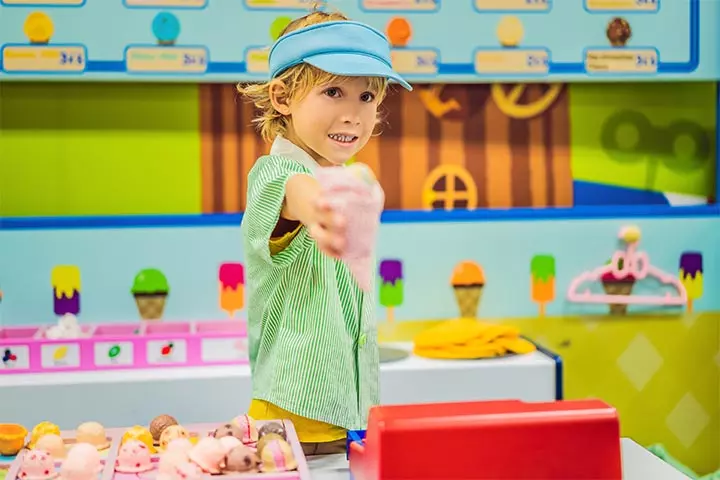
You can get your child a play ice cream cart and ask them to serve you an ice cream cone. They can give the cart a name and mix flavors to come up with a new, unique ice cream flavor.
Practical tips
- Use cotton balls, pom-poms, or colored sponges as scoops.
- Encourage naming new flavors like Rainbow Crunch or Dino Delight.
Challenges and solutions
- Sticky confusion with real treats: Ensure your child is aware that these are pretend ice creams and not real ones.
- Spillage of tiny props: Use trays or shallow bins to contain items.
How To Choose Suitable Toys For Pretend Play?
Choosing suitable toys for pretend play involves considering the child’s age, interests, and developmental stage. For toddlers, select simple and safe toys, like dolls, stuffed animals, and toy vehicles, that encourage exploration. As children grow, they opt for more complex sets that stimulate imagination, such as dress-up costumes, play kitchens, or toolsets. Ensure the toys are age-appropriate and do not have small parts that could be choking hazards. Look for open-ended and versatile toys, allowing for a range of creative scenarios. Encourage gender-neutral play by selecting a variety of toys and avoiding stereotypes. High-quality, durable materials ensure longevity and safety. Finally, consider educational value; toys that mimic real-life situations, like doctor’s kits or grocery stores, can help stimulate imagination, promote life skills, and support various developmental stages.
Frequently Asked Questions
1. How do I teach my child pretend plays?
To teach children pretend plays, you should (7)
- Show the actions and gestures you want them to learn
- Observe their interests and play with them accordingly
- Introduce new toys but do not get too many toys at a time
- Introduce simple actions and keep repeating them until they learn
- Get involved in the pretend plays
- Expose children to new ideas and experiences
2. What are the stages of pretend play?
The stages of pretend play are (7):
- Self pretend (12- 18 months): Children pretend to do a single task.
- Simple pretend (18- 24 months): Children perform simple actions with toys or people.
- Series of familiar actions (24- 30 months): Children pretend to perform actions from familiar routines.
- Series of less familiar actions (30-36 months): Children learn to perform actions based on new themes.
- Role play (three to five years): Children choose imaginary themes for pretend plays. They may also perform on stage with others.
3. What is the psychology of pretend play?
Pretend play is one of the types of play that is essential to a child’s development, including linguistic, social, emotional, and cognitive domains. It promotes creativity, empathy, self-regulation, and problem-solving skills while supporting the development of various talents and capacities.
4. What are some creative ways to enhance pretend play at home?
To enhance pretend play, create themed areas in your home, such as a mini market or a doctor’s office. You may pick fun costumes for your child and encourage them to use everyday items as props to develop their creativity and imagination. Reading imaginative stories and asking children to enact the situations can also add fun to the pretend play sessions.
Pretend play for kids is a fun way for them to mimic what they see around them. Apart from the ideas mentioned above your child can also pretend to be a builder who creates a building using cardboard blocks. Pretending to be someone else or be in an imaginary situation is an art that can hone a child’s imagination and creativity. It also helps them to express themselves better. Also, interacting with other children during pretend play can boost their social, communication, and cognitive abilities. But it can be effective only if there is full cooperation from your child. So, nurture your little one’s innate interest in pretend play by providing them with age-appropriate toys. Further, play along with them using these engaging and entertaining pretend play ideas for kids to make this natural learning process more fun and exciting.
Infographic: Potential Benefits Of Pretend Play In Your Child’s Development
Pretend play or imaginative play develops thinking skills in children and helps them stay entertained for hours. Children can use their imagination to become anything or visit any place while playing. This forms an important part of their psychological development. The infographic below highlights the benefits of pretend play for children.
Some thing wrong with infographic shortcode. please verify shortcode syntaxIllustration: Best Ideas Of Pretend Play For Kids And Its Benefits

Image: Stable Diffusion/MomJunction Design Team
Vlad and Niki are back with another exciting adventure! Watch as they pretend play with their toys and tell funny stories for children. Get ready to be giggled and entertained thoroughly!
Personal Experience: Source
MomJunction articles include first-hand experiences to provide you with better insights through real-life narratives. Here are the sources of personal accounts referenced in this article.
i. Farm dramatic play;https://pocketofpreschool.com/farm-dramatic-play-center/
References
1. Positive Parenting Tips: Toddlers (1–2 years old); CDC
2. Toddlers (2-3 years of age) – Developmental Milestones; CDC
3. Myae Han;Does Play Make a Difference?; How play intervention affects the vocabulary learning of at-risk preschoolers; University of Illinois
4. 4 Benefits of Imaginative Play for Young Children; Horizon Education Centers
5. The benefits of imaginative play; Therapy Focus
6. Social Development in Preschoolers; American Academy of Pediatrics
7. The Land of Make Believe: How and Why to Encourage Pretend Play; The Hanen Centre
Community Experiences
Join the conversation and become a part of our nurturing community! Share your stories, experiences, and insights to connect with fellow parents.
Read full bio of Beth Sullivan
Read full bio of Nisha Bharatan
Read full bio of Harshita Makvana
Read full bio of Trisha Chakraborty






